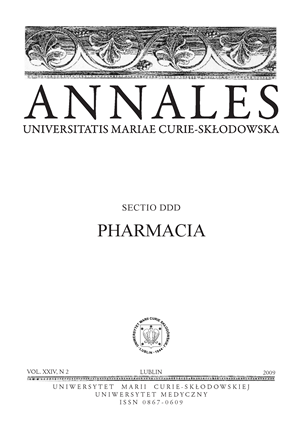Wpływ pioglitazonu na wydzielanie podstawowe kwasu żołądkowego u szczurów leczonych omeprazolem
DOI:
https://doi.org/10.2478/v10080-008-0189-4Abstrakt
W doświadczeniu na szczurach wykazano, że codzienne podawanie omeprazolu (14 mg/kg,
i.p.) przez okres 28 dni powodowało wzrost poziomów osoczowych gastryny o 189,3 % (p < 0,05).
W efekcie tego dochodziło do rozwoju hipertrofii śluzówki żołądka, co skutkowało wzrostem
wydzielania kwasu żołądkowego o 283,7 % (p < 0,01). W grupie szczurów, którym przez okres 28
dni podawano pioglitazon i omeprazol, wydzielanie kwasu żołądkowego była o 53,4 % niższe niż u szczurów otrzymujących wyłącznie omeprazol. Pioglitazon nie wpływał jednakże na podwyższone
stężenie gastryny w osoczu wywołane podawaniem omeprazolu. Kompensacyjny efekt pioglitazonu
na wydzielanie kwasu żołądkowego może wskazywać na opóźnienie rozwoju procesu hipertrofii śluzówki żołądka wywołane przez hipergastrynemię.
Bibliografia
1. Demetri G. D., Fletcher C. D., Mueller E. et al.: Induction of solid tumor differentiation by the peroxisome proliferator-activated receptor-gamma ligand troglitazone in patients with liposarcoma. Proc. Natl .Acad. Sci. U.S.A., 96 (7), 3951, 1999.
2. Elnem r A., Ohta T., Iwata K. et al.: PPARgamma ligand (thiazolidinedione) induces growth arrest and differentiation markers of human pancreatic cancer cells. Int. J. Oncol., 17 (6), 1157, 2000.
3. Fukui H., Kinoshita Y., Maekawa T. et al.: Regenerating gene protein may mediate gastric mucosal proliferation induced by hypergastrinemia in rats. Gastroenterology, 115 (6), 1483, 1998.
4. Ghosh M. N., Shild H. O.: Continuous recording of acid gastric secretion in the rat. Br. J. Pharmacol., 13, 1958.
5. Larsson H., Carlsson E., Ryberg B. et al.: Rat parietal cell function after prolonged inhibition of gastric acid secretion. Am. J. Physiol., 254 (1), G33, 1988.
6. Mueller E., Sarraf P., Tontonoz P. et al.: Terminal differentiation of human breast cancer through PPAR gamma. Mol. Cell., 1 (3), 465, 1998.
7. Nakajima T., Konda Y., Izumi Y. et al.: Gastrin stimulates the growth of gastric pit cel precursors by inducing its own receptors. Am. J. Physiol. Gastrointest. Liver Physiol., 282 (2), G359, 2002.
8. Nomura S., Nakajima A., Ishimine S. et al. Differential expression of peroxisome proliferator-activated receptor in histologically different human gastric cancer tissues. J. Exp. Clin. Cancer Res., 25 (3), 443, 2006.
9. Socia E., Capella C., Flocca R. et al.: Gastric argyrophil cancinoidosis in patients with Zollinger Ellison syndrome due to type I multiple endocrine neoplasia: A newly recognized association. Am. J. Surg. Pathol., 14, 503, 1990.
10. Tsyryuk O. I., Voronina O. I., Ovcharic T. V. et al.: The influence of different duration hypergastrinemia on structure functional state of gastric mucosa in rats Abstract of international conference “The mechanisms of functions of physiological systems”, С.152, Lviv 2006.
Pobrania
Opublikowane
Numer
Dział
Licencja
Prawa autorskie (c) 2009 Autorzy

Praca jest udostępniana na licencji Creative Commons Attribution-NonCommercial-NoDerivatives 3.0 Unported License.


